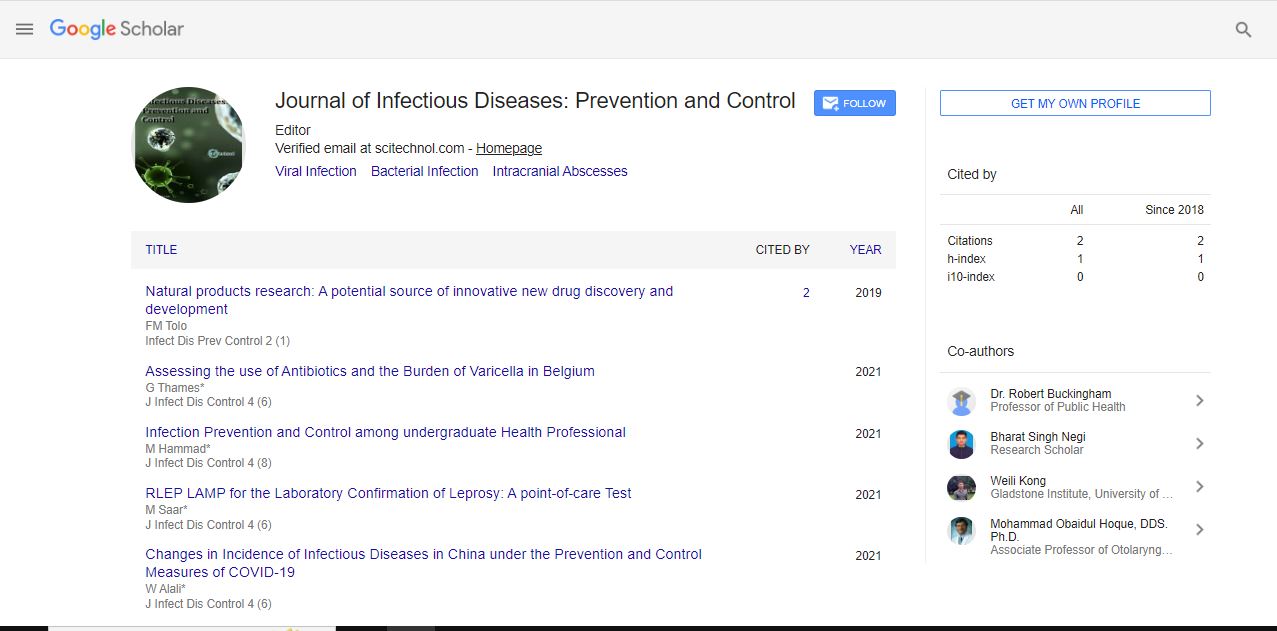Short Communication, Infect Dis Prev Control Vol: 6 Issue: 4
Exploring Bacterial Infections through Colonization to Confrontation
Vignon Dalbeni*
1Department of Medicine, University of Verona, Verona, Italy
*Corresponding Author: Vignon Dalbeni,
Department of Medicine, University of
Verona, Verona, Italy
E-mail: vigdalbe@aovr.veneto.it
Received date: 24 November, 2023, Manuscript No. IDPC-24-127257;
Editor assigned date: 27 November, 2023, Pre QC No. IDPC-24-127257 (PQ);
Reviewed date: 11 December, 2023, QC No. IDPC-24-127257;
Revised date: 18 December, 2023, Manuscript No. IDPC-24-127257 (R);
Published date: 26 December, 2023, DOI: 10.36648/idpc.6.4.146
Citation: Dalbeni V (2023) Exploring Bacterial Infections through Colonization to Confrontation. Infect Dis Prev Control 6:4.
Description
Bacterial infections, a persistent challenge to human health, occur in a dynamic manner that spans from initial colonization to the eventual confrontation with the host's immune defenses. This exploration delves into the complex pathogenic bacteria perform, examining the stages of colonization, establishment and the subsequent confrontation, shedding light on the mechanisms that support this complex connection. The path that microorganisms take to cause infections commences with colonization, where bacteria establish residence within the host. This phase is characterized by the interaction between bacterial pathogens and the host's tissues, often involving the adherence of bacteria to specific cellular or mucosal surfaces.
During colonization, bacteria employ a variety of strategies to evade the host's defense mechanisms. Adherence factors, such as pili and fimbriae, facilitate the binding of bacteria to host cells, enabling the establishment of a solid base. The success of this initial interaction sets the stage for subsequent events, influencing the severity and course of the infection. Following successful colonization, bacterial pathogens undergo proliferation and establishment, rapidly multiplying and spreading within the host. This phase is marked by the exploitation of host resources, the production of toxins and the modulation of the host's immune response to produce a favorable environment for bacterial survival [1,2].
The establishment phase varies in duration and intensity depending on the bacterial species and the host's susceptibility. Some bacteria remain localized, causing localized infections, while others have the potential to disseminate systemically, leading to more severe and widespread consequences. Understanding the complexities of bacterial establishment is essential for developing specific actions to disrupt the progression of infection. The dynamic interaction between bacterial pathogens and the host's immune system is a vital aspect of the expedition from colonization to confrontation. The host's immune response involves both intrinsic and adaptable components, each playing distinct roles in recognizing and eliminating bacterial invaders [3-5].
In the intrinsic immune response, cells such as neutrophils and macrophages act as first responders, engulfing and neutralizing bacteria. Complement proteins enhance the recognition and destruction of bacteria, contributing to the early defense against infection. Simultaneously, the adaptive immune response, orchestrated by T and B lymphocytes, develops a specific defense against specific bacterial antigens, conferring a memory response for future encounters. Confrontation represents the culmination of the host's response to bacterial infection. The immune system mounts a concerted effort to eliminate or control the invading bacteria. Inflammatory responses characterized by the release of cytokines and chemokines, aim to recruit immune cells to the site of infection and enhance the destruction of bacteria. In some cases, the confrontation results in the successful clearance of the bacterial infection. However, certain bacterial species have evolved sophisticated mechanisms to evade or subvert the immune response, leading to persistent or chronic infections. These scenarios may necessitate prolonged and customized therapeutic interventions to aid the host in overcoming bacterial challenges [6-8].
The expedition from colonization to confrontation manifests clinically in various ways, ranging from localized symptoms to systemic manifestations. Localized infections may present with redness, swelling and discharge at the site of bacterial entry, while systemic infections can lead to fever, sepsis and organ dysfunction. Treatment strategies for bacterial infections hinge on the identification of the causative agent, its susceptibility to antimicrobial agents and the severity of the infection. Antibiotics, antivirals and other antimicrobial agents may be employed to customize and eliminate bacterial pathogens. However, the emergence of antibiotic resistance underscores the ongoing challenge in managing bacterial infections, necessitating judicious and informed use of antimicrobial therapies [9,10].
Conclusion
Understanding the expedition from colonization to confrontation is integral to the development of effective prevention strategies. Vaccination, sanitation practices and public health measures aim to interrupt the transmission of bacterial pathogens and reduce the overall burden of infections within communities. Looking ahead, advancements in molecular biology, immunology and epidemiology has potential for more specific and personalized approaches to managing bacterial infections. Exploring bacterial infections through the stages of colonization to confrontation provides a comprehensive perspective on the challenges posed by these microbial adversaries.
References
- Hancock RE, Nijnik A, Philpott DJ (2012)Modulating immunity as a therapy for bacterial infections. Nat Rev Microbiol 10:243-254.
- Hornef MW, Wick MJ, Rhen M, Normark S (2002) Bacterial strategies for overcoming host innate and adaptive immune responses. Nat Immunol 3:1033-1040.
- Heinzelmann M, Scott M, Lam T (2002) Factors predisposing to bacterial invasion and infection. Am J Surg 183:179-190.
- Janeway Jr CA, Medzhitov R (2002) Innate immune recognition. Annu Rev Immunol 20:197-216.
- Paludan SR, Pradeu T, Masters SL, Mogensen TH (2021) Constitutive immune mechanisms: Mediators of host defence and immune regulation. Nat Rev Immunol 21:137-150.
- Monack DM, Mueller A, Falkow S (2004) Persistent bacterial infections: The interface of the pathogen and the host immune system. Nat Rev Microbiol 2:747-765.
- Finlay BB, McFadden G (2006) Anti-immunology: Evasion of the host immune system by bacterial and viral pathogens. Cell 124:767-782.
- Shepherd FR, McLaren JE (2020) T cell immunity to bacterial pathogens: Mechanisms of immune control and bacterial evasion. Int J Mol Sci 21:6144.
- Muteeb G, Rehman MT, Shahwan M, Aatif M (2023) Origin of antibiotics and antibiotic resistance, and their impacts on drug development: A narrative review. Pharmaceuticals (Basel) 16:1615.
- Adebisi YA (2023) Balancing the risks and benefits of antibiotic use in a globalized world: the ethics of antimicrobial resistance. Global Health 19:27.
 Spanish
Spanish  Chinese
Chinese  Russian
Russian  German
German  French
French  Japanese
Japanese  Portuguese
Portuguese  Hindi
Hindi 